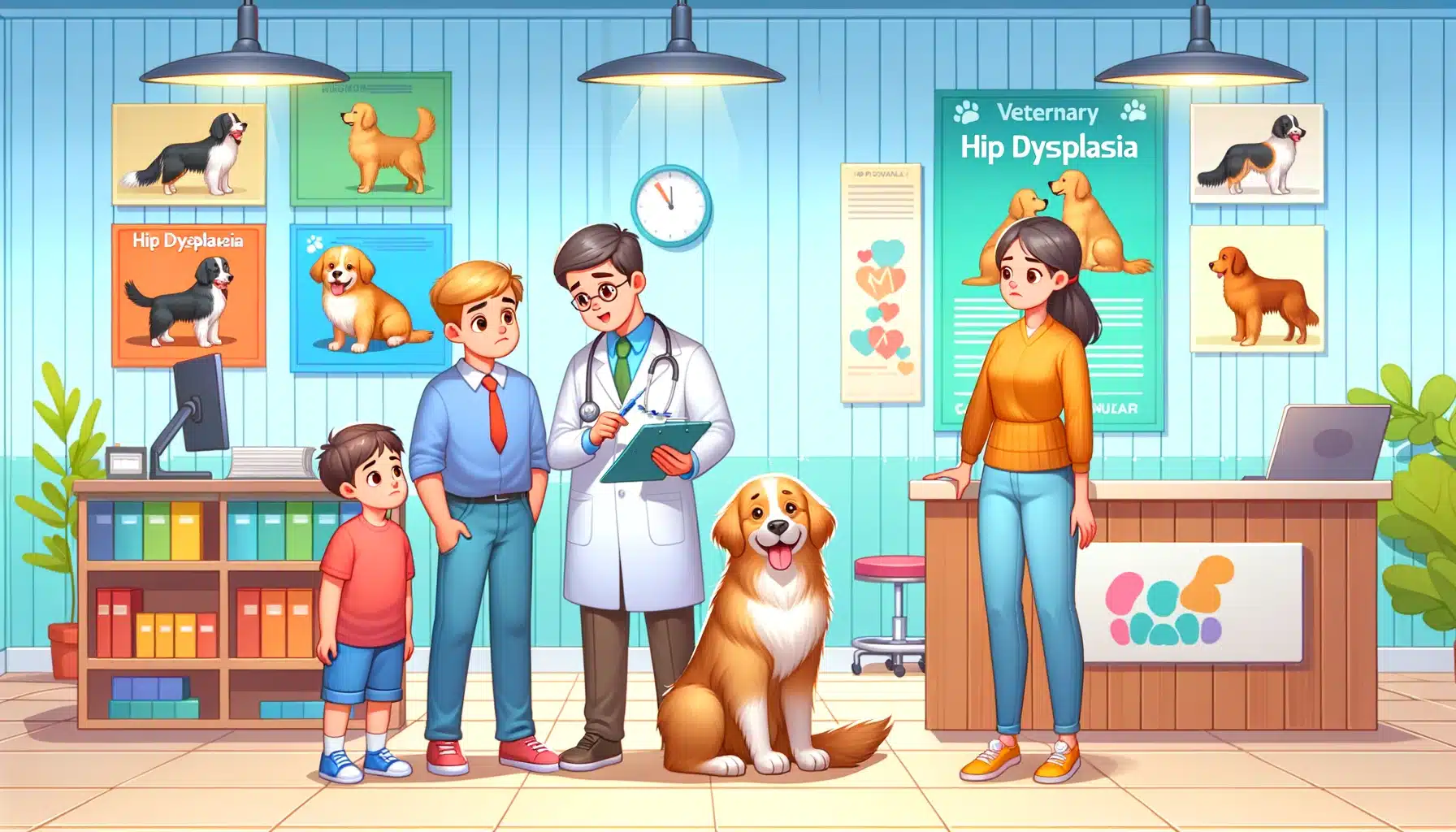Hip Dysplasia in Golden Retrievers. It is a common skeletal condition that affects many large breed dogs, including Golden Retrievers. This hereditary health problem can cause lifelong discomfort, mobility issues, and even lead to canine arthritis if left unmanaged. Despite the popularity of Golden Retrievers as family pets, many owners may not be aware of this potentially serious issue affecting their beloved canine companions.

Understanding the causes and symptoms of hip dysplasia is crucial in preventing and managing the condition effectively. Genetics play a significant role in the development of hip dysplasia, with larger breeds like Golden Retrievers, Labrador Retrievers, and German Shepherds being more susceptible due to their rapid growth rates. Environmental factors, such as diet, exercise, and weight, also contribute to the likelihood of developing this condition. It’s vital to educate oneself about hip dysplasia and take necessary precautions to ensure one’s pet stays healthy throughout its life.
Recognizing early signs can make all the difference in providing timely treatment and improving the quality of life for dogs suffering from hip dysplasia. Some common symptoms include limping, stiffness, difficulty in moving, and reluctance to engage in physical activities. By detecting these signs promptly and consulting a veterinarian, Golden Retriever owners can create an effective treatment plan to manage both the pain and the progression of this condition.
Understanding Hip Dysplasia
Definition of Hip Dysplasia
Hip dysplasia is a common health condition affecting many dog breeds, particularly Golden Retrievers1. So, what exactly is hip dysplasia? It’s a progressive, degenerative disorder in which the hip joint fails to develop properly, leading to joint instability, deterioration, and, ultimately, loss of function.
Anatomy of the Hip Joint
To grasp the concept of hip dysplasia, it’s essential to understand the anatomy of the hip joint. A dog’s hip joint is a ball and socket joint, consisting of two main components: the femoral head (the “ball”) and the acetabulum (the “socket”)2. A healthy joint is characterized by a snug, secure fit between the two parts that allows for smooth, pain-free movements.
In hip dysplasia, the socket may be shallow, providing insufficient femoral head coverage3, or the ball and socket may not align correctly. This mismatch leads to joint laxity or instability, causing excessive wear and tear on the joint’s cartilage, resulting in discomfort, inflammation, and, potentially, arthritis.
Genetic Factors in Golden Retrievers
Why are Golden Retrievers more prone to hip dysplasia? Genetics play a significant role in determining the likelihood of a dog developing this condition4. In fact, it is a hereditary disease that can be passed down through multiple generations.
However, genetic factors alone do not necessarily guarantee that a dog will develop hip dysplasia. Environmental factors, such as a dog’s diet, exercise levels, and overall health, also contribute to the risk of developing this disorder. As a dog owner, being proactive in providing a balanced diet, regular exercise, and maintaining a healthy weight for your Golden Retriever can help reduce the risk of hip dysplasia, ensuring that your furry friend stays happy and comfortable throughout their life.
Remember, early detection and intervention are key to managing hip dysplasia and mitigating its potential effects on your Golden Retriever. Consult with your veterinarian regularly to monitor your dog’s joint health and discuss potential strategies to prevent or manage this condition.
Footnotes
- https://www.officialgoldenretriever.com/blog/health-nutrition/hip-dysplasia-and-golden-retrievers-your-all-one-guide/ ↩
- https://goldenretrieversociety.com/hip-dysplasia/ ↩
- https://resources.integricare.ca/blog/golden-retriever-hip-dysplasia ↩
- https://iheartgoldens.com/how-to-tell-if-golden-retriever-has-hip-dysplasia/ ↩
Identifying Symptoms

Golden Retrievers can be susceptible to hip dysplasia and it’s important to recognize its symptoms early on. This section will cover common signs of hip dysplasia and related behavioral changes.
Common Signs of Hip Dysplasia
Hip dysplasia often presents a variety of symptoms in Golden Retrievers that can be easily spotted if one knows what to look for. Some of the most common signs include:
- Limping: An uneven or uncomfortable gait may indicate discomfort in the hip area.
- Swaying: A noticeable side-to-side motion during walking, also known as a swaying gait, is a characteristic sign.
- Stiffness: Affected dogs often have difficulty moving their hind legs or show signs of stiffness in their movements.
- Lameness: Hind leg lameness can be a clear indication of joint problems like hip dysplasia.
- Difficulty rising: If your pet struggles to stand up, especially after sleeping or resting, it might suggest hip discomfort.
These symptoms can be indicative of hip dysplasia, so it’s essential to consult your veterinarian if you notice any of them in your Golden Retriever.
Behavioral Changes and Pain
In addition to the physical manifestations of hip dysplasia, the condition can cause several behavioral changes related to pain and discomfort. For example:
- Decreased activity: A dog experiencing pain will typically be less active and might resist playing or engaging in normal activities.
- Pain: They might vocalize or whimper during movement or when touched on affected areas.
- Reluctance to be touched: An otherwise friendly dog might start avoiding pets, hugs, or touch due to discomfort.
Remember, recognizing these symptoms is the first step in identifying and managing hip dysplasia in your golden retriever. If you notice any of these signs, don’t hesitate to reach out to your veterinarian for a thorough examination and diagnosis. Keeping a watchful eye on your furry friend and addressing concerns early on can make a huge difference in their overall quality of life.
Diagnosis and Severity Assessment
When it comes to hip dysplasia in Golden Retrievers, early detection and assessment of severity play an important role in determining the best course of treatment. In this section, we will explore two methods used in the diagnosis and assessment of this condition: physical and orthopedic examinations and radiographic imaging techniques.
Physical and Orthopedic Exams
A veterinarian typically begins the diagnostic process by conducting a thorough physical exam, observing the dog’s gait, and checking for symptoms of hip dysplasia such as limping, stiff or swollen joints, and lethargy. Orthopedic exams, on the other hand, involve manipulation of the dog’s hip joints to check for pain, range of motion, and instability.
When is the ideal time to conduct these routine examinations? Well, Golden Retrievers should be regularly evaluated for hip dysplasia as they grow, since early detection can make a difference in managing this condition effectively.
Radiographic Imaging Techniques
To further confirm the diagnosis and assess the severity of hip dysplasia, radiographic imaging techniques such as X-rays are employed. One notable method for evaluating canine hip joints is the PennHIP technique. This method measures the degree of joint laxity or looseness, which can be an indicator of susceptibility to hip dysplasia.
Another well-respected organization for evaluating canine hip dysplasia is the Orthopedic Foundation for Animals (OFA). They use a scoring system based on radiographs that grades the hips as excellent, good, fair, borderline, or dysplastic.
So, how do veterinarians decide which technique to use? Both PennHIP and OFA methods have their merits, and it often depends on the veterinarian’s preference or the specific needs of the Golden Retriever.
In conclusion, early diagnosis and severity assessment of hip dysplasia in Golden Retrievers are crucial for effective treatment and management. Through a combination of physical and orthopedic examinations, as well as radiographic imaging techniques like PennHIP and OFA, it’s possible to determine the best course of action for each individual dog.
Treatment Options
Non-Surgical Interventions
There are various non-surgical treatments available for hip dysplasia in Golden Retrievers. One of the most common is medical management, which involves the use of nonsteroidal anti-inflammatory drugs (NSAIDs) or other pain medications to reduce inflammation and discomfort1. In conjunction with medication, routine exercise and physical therapy can be recommended to maintain muscle tone and joint flexibility, ensuring your dog stays at a healthy weight and doesn’t put unnecessary strain on affected joints2.
Another option is acupuncture, an alternative therapy that could alleviate pain and improve joint function3. In addition, some owners opt for joint supplements like glucosamine and chondroitin to support joint health, but it is essential to consult with your veterinarian before starting any supplement regimen4.
Surgical Procedures
When non-surgical interventions are insufficient, more severe cases of hip dysplasia may require surgical procedures. Two common surgeries include:
- Total Hip Replacement (THR): This procedure involves replacing the damaged hip joint with an artificial implant, providing smooth movement and significant pain relief5.
- Femoral Head Ostectomy (FHO): This surgery focuses on removing the femoral head (ball part) of the joint to eliminate bone-on-bone contact, allowing scar tissue to form a pseudo-joint6.
In some cases, a Triple Pelvic Osteotomy (TPO) may be performed, which repositions the hip socket for improved stability and function7. However, this procedure is typically reserved for younger dogs with less severe hip dysplasia8.
It’s essential to work closely with your veterinarian to determine the most appropriate course of action for your Golden Retriever’s specific needs and weigh the risks and benefits of surgical intervention. Remember, proper care and monitoring can help ensure a healthy, happy life despite hip dysplasia.
Footnotes
- https://www.akc.org/expert-advice/health/hip-dysplasia-in-dogs/ ↩
- https://resources.integricare.ca/blog/golden-retriever-hip-dysplasia ↩
- https://www.officialgoldenretriever.com/blog/health-nutrition/hip-dysplasia-and-golden-retrievers-your-all-one-guide/ ↩
- https://goldenretrieversociety.com/hip-dysplasia/ ↩
- https://resources.integricare.ca/blog/golden-retriever-hip-dysplasia ↩
- https://www.akc.org/expert-advice/health/hip-dysplasia-in-dogs/ ↩
- https://iheartgoldens.com/how-to-tell-if-golden-retriever-has-hip-dysplasia/ ↩
- https://www.officialgoldenretriever.com/blog/health-nutrition/hip-dysplasia-and-golden-retrievers-your-all-one-guide/ ↩
Role of Diet and Nutrition
Proper Nutrition for Joint Health
A well-balanced diet plays a crucial role in maintaining your Golden Retriever’s overall health, especially when it comes to their joints. Overweight dogs are more prone to hip dysplasia due to the increased stress on their joints1. By providing a diet that is rich in nutrients and maintaining a healthy weight, you can help prevent hip dysplasia in your Golden Retriever.
Some key elements of a proper diet for joint health include:
- High-quality protein sources: Lean meats like chicken, turkey, and fish are great options for providing the essential amino acids needed for healthy muscle growth and maintenance.
- Healthy fats: Omega-3 fatty acids found in fish oil, flaxseed, and other sources can help reduce inflammation and support joint health.
- Balanced carbohydrates: Complex carbohydrates like sweet potatoes, brown rice, and quinoa provide energy without causing rapid weight gain which can lead to obesity.
Supplements and Nutrients
When aiming to promote joint health and potentially prevent conditions like hip dysplasia, incorporating certain supplements and nutrients into your Golden Retriever’s diet can be highly beneficial. Two key supplements often recommended for joint health are glucosamine and chondroitin2. Both play an essential role in maintaining cartilage health and reducing inflammation.
Some other important nutrients to consider for joint health include:
- Calcium: Adequate calcium intake is crucial for bone health, particularly during your dog’s rapid growth phase.
- Vitamin D: Important for calcium absorption, helping ensure that your dog’s bones stay strong and healthy.
- Antioxidants: Antioxidants, such as vitamins C and E, can help reduce inflammation and aid in maintaining healthy joints.
Remember, before starting your dog on any new supplements or making significant changes to their diet, it’s essential to consult with your veterinarian. They can provide personalized recommendations based on your dog’s needs and health status.
In summary, a well-rounded diet and proper nutrition play a pivotal role in maintaining your Golden Retriever’s joint health and preventing hip dysplasia. By incorporating the right nutrients and supplements, you can help give your furry friend the best possible chance at a long, active, and healthy life.
Footnotes
Managing Hip Dysplasia in Daily Life
Exercise and Activity Modifications
Managing hip dysplasia in Golden Retrievers involves adapting their daily activities and exercise routines to ensure they are comfortable and supported. Swimming is a low-impact exercise that can help build muscle without causing undue stress on their joints, particularly the hips. Can you picture your furry friend enjoying a splash in the water?
Introducing other types of exercise that focus on strengthening muscles supporting the hip joint can also be beneficial. For example, consider incorporating simple activities like walking on soft surfaces, and avoid activities requiring sharp turns or significant jumping. Canine rehabilitation specialists can work with pet owners to design exercise programs tailored to specific needs. Isn’t it great knowing there are experts available to help?
Environmental Adjustments
In addition to exercise modifications, making changes to your Golden Retriever’s environment can further alleviate discomfort and improve the quality of their life. One way to do this is by providing an orthopedic bed for your canine friend. This will offer them improved support and comfort for their joints during rest.
To ease movement around the home, consider placing area rugs or non-slip mats on slippery floors to prevent slips and sliding. You might also want to think about installing ramps to replace steps, making it easier for your lovable companion to move around without causing stress on their hips.
Making these lifestyle modifications can improve your Golden Retriever’s ability to manage hip dysplasia symptoms, ultimately allowing them to enjoy a higher quality of life. Remember, it’s equally important to maintain open communication with your veterinarian, who can provide valuable guidance on further supportive measures.
Prevention Strategies

Responsible Breeding Practices
Preventing hip dysplasia in Golden Retrievers starts with responsible breeding practices. Genetics play a significant role in the development of this condition, and it’s crucial for breeders to be aware of the dog’s lineage and the prevalence of hip dysplasia in their gene pool. Some breeds are more susceptible to hip dysplasia than others, such as German Shepherds, Labrador Retrievers, Great Danes, and Saint Bernards.
Breeders should screen their dogs for hip dysplasia and only breed dogs with healthy hips. Working with veterinarians who understand the nuances of hip dysplasia can help breeders make informed decisions about their programs.
Imagine you’re an aspiring breeder, and you meet with a veterinarian for advice. The vet uses a gentle approach to explain the benefits of responsible breeding. Together, you work on a plan to select healthy dogs for breeding and integrate environmental factors like diet, exercise, and living conditions into the dogs’ lifestyles to minimize the chances of hip dysplasia developing.
Early Detection and Intervention
Time is of the essence when it comes to detecting and treating hip dysplasia. Early intervention can significantly improve the quality of life for dogs with this condition. Regular checkups with a veterinarian are essential for detecting any signs of hip dysplasia in your puppy or adult dog. As the symptoms worsen, your dog may exhibit signs like limping, stiff joints, or reluctance to be touched.
Golden Retriever owners should ask their vet for advice on nutrition and weight management, tailored exercise programs, and joint support supplements. Imagine a young Golden Retriever named Max, who had early signs of hip dysplasia. Max’s owner took the vet’s advice and began an exercise program and added joint supplements to Max’s diet. This early intervention helped Max maintain an active, happy lifestyle despite his condition.
While it’s impossible to eliminate hip dysplasia from every breeding line, responsible breeding practices and early intervention can help mitigate the effects of this disorder in many Golden Retrievers. Being proactive in addressing these issues can lead to happier, healthier dogs and better outcomes for all involved.
Understanding Associated Conditions
Related Orthopedic Disorders
Hip dysplasia in Golden Retrievers is a type of orthopedic disorder affecting the ball and socket joint of the hips1. When hip dysplasia occurs, the joint becomes less stable, leading to joint laxity and instability2. Golden Retrievers, like any other dog breed, can also experience other orthopedic disorders, such as arthritis and osteoarthritis.
Arthritis, for example, is an inflammation of the joints that can cause pain and stiffness. In canines with hip dysplasia, arthritis can often develop as a secondary condition resulting from the joint instability3. On the other hand, osteoarthritis is the wear and tear of joint cartilage, causing the bones to rub against each other, leading to even more pain and inflammation4.
Complications Arising from Hip Dysplasia
Hip dysplasia is not just an isolated issue, but one that can lead to various health complications in Golden Retrievers. Some common issues that can arise from hip dysplasia include:
- Decreased range of motion: This occurs as the joints become more unstable, causing difficulty in movement3. You can imagine the struggle of a once active and playful dog, now unable to fully enjoy their favorite activities.
- Joint instability: When the ball and socket joint is malformed, the joint may experience instability5. This can lead to further complications, such as dislocations, if not treated properly.
- Pain and inflammation: The rubbing of bones in an unstable joint will often result in inflammation and pain3. This can make even the simplest of movements, like lying down, a challenge for your beloved pet.
The effects of hip dysplasia can greatly impact a dog’s quality of life, taking away the joy of running and playing. The good news is that there are treatments available to help manage symptoms and improve your Golden Retriever’s overall wellbeing.
As a responsible pet owner, it’s essential to be aware of the signs, symptoms, and management options for hip dysplasia and other orthopedic disorders in Golden Retrievers. Understanding these conditions can help you provide the best possible care for your furry friend, ensuring they live a happy, healthy life.
Footnotes
- https://goldenretrieversociety.com/hip-dysplasia/ ↩
- https://www.officialgoldenretriever.com/blog/health-nutrition/hip-dysplasia-and-golden-retrievers-your-all-one-guide/ ↩
- https://iheartgoldens.com/how-to-tell-if-golden-retriever-has-hip-dysplasia/ ↩ ↩2 ↩3
- https://www.pethonesty.com/blogs/blog/a-guide-to-golden-retriever-hip-dysplasia ↩
- https://resources.integricare.ca/blog/golden-retriever-hip-dysplasia ↩









